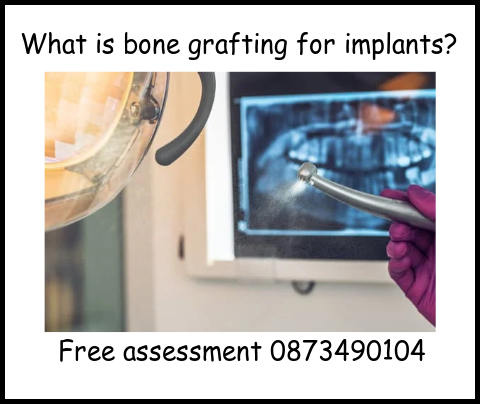Bone grafting for dental implants is a common enough procedure, learn about what is bone grafting for implants including what is the procedure, types of bone grafting, advantages of bone grafting and the cost of bone grafting for implants.
Bone grafting is a surgical procedure used to enhance the quality and quantity of bone in a specific area of the body, typically in preparation for dental implant placement.
This procedure is essential for patients who have suffered bone loss or have inadequate natural bone to support dental implants.

During the procedure
During bone grafting for implants, a small amount of bone is taken from another part of the patient’s body, such as the chin, jaw, hip, or tibia.
Alternatively, synthetic bone graft materials or cadaveric bone can be used. This bone graft is then placed at the site where the implant will be inserted.
Bone grafting techniques
There are several types of bone grafting techniques available, which may include:
1. Autograft:
This involves using the patient’s own bone, which is typically harvested from another area of the body. Autografts have the advantage of being readily available and having a high success rate.
2. Allograft:
In this technique, bone graft material is obtained from a donor, usually a cadaver. The harvested bone is thoroughly processed and sterilized to ensure safety.
Allografts eliminate the need for a second surgical site to harvest bone from the patient, making the procedure less invasive.
3. Xenograft:
This involves using bone graft material derived from animals, typically bovine or porcine sources. The animal bone is processed to remove any organic material, leaving behind a mineral scaffold that promotes new bone growth.
Xenografts are widely used and have proven to be effective in stimulating bone regeneration.
4. Synthetic grafts:
These grafts consist of synthetic materials specifically designed to resemble natural bone, such as hydroxyapatite or tricalcium phosphate. These materials provide a framework for new bone growth to occur.
Choice of bone grafting techniques
The choice of bone grafting technique depends on various factors, including the patient’s overall health, the extent of bone loss, and the location of the implant.
Our dental oral surgeon at Perfect Smile Dental will carefully evaluate your individual case and recommend the most suitable bone grafting method.
First and foremost you should call Fintan 0873490104 for a free assessment in our Irish clinic in Wexford town.

Stable foundation
Bone grafting allows for the creation of a stable foundation by promoting bone regeneration and integration with the surrounding tissues.
This process enhances the success rate and longevity of dental implants, ensuring they have a secure and durable support implants.
What is the price for dental implants is a must read.
Prices in Ireland and Hungary bone grafting for implants
Bone grafting is a common procedure performed before implant placement to ensure stability and successful integration of dental implants.
The cost of bone grafting for implants can vary significantly depending on geographical location. This comparative analysis aims to provide professionals and patients an insight into the price differences between Ireland and Hungary.
Ireland:
As a developed European country, Ireland offers advanced medical facilities and a high standard of care. Consequently, the prices for bone grafting procedures associated with dental implants tend to be relatively higher.
On average, bone grafting for implants in Ireland could range from €500 to €2,500 per site, depending on the complexity of the procedure.
Factors contributing to the higher prices in Ireland are:
1. Labor Costs:
Healthcare professionals in Ireland are remunerated at higher rates compared to other countries, leading to increased treatment costs.
2. Material Costs:
The cost of medical supplies, instruments, and bone grafting materials are typically higher due to import and distribution expenses.
3. Overhead Expenses:
Operating costs, including rent, maintenance, and administration, are relatively higher in Ireland, which is reflected in the overall treatment fees.
Hungary:
Hungary has gained recognition as a popular dental tourism destination due to its well-established reputation for affordable and high-quality dental treatments.
The cost of bone grafting for implants in Hungary tends to be significantly lower compared to Ireland.
On average, bone grafting for implants in Hungary could range from €300 to €1,500 per site, depending on the complexity of the procedure, for a more detailed cost call Fintan 0873490104 for a free assessment in Wexford town clinic.
The lower prices can be attributed to the following factors:
1. Competitive Market:
The presence of numerous dental clinics in Hungary creates a highly competitive environment, resulting in more affordable prices to attract international patients.
2. Lower Living Costs:
Hungary has a lower cost of living compared to Ireland, leading to reduced labor and overhead expenses for dental clinics, which are then passed on to patients.
3. Favorable Exchange Rates:
The exchange rate between the Hungarian Forint (HUF) and the Euro (EUR) is often advantageous for patients seeking dental treatment, making Hungary a cost-effective destination.
Conclusion:
When comparing the prices of bone grafting for implants between Ireland and Hungary, significant variations are observed. Ireland, with its higher standard of care and associated costs, tends to have higher prices for bone grafting procedures.
On the other hand, Hungary, known for its affordable dental tourism, offers considerably lower prices for the same procedures.
It is important to note that bone grafting procedures typically require a healing period before dental implant placement can occur.
Your dental professional will guide you through the preparation and recovery process, ensuring optimal outcomes for your dental implant treatment.
References
https://www.ncbi.nlm.nih.gov/pmc/articles/PMC5601489/

